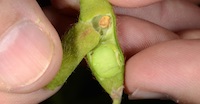Still time for pests to ruin dreams of high soybean yields

Soybean Pest Beat: Scout and know which insects and diseases you can still take action against, and which you can’t.
Tom J Bechman 1 | Jul 04, 2017
What insects do I still need to watch for in soybeans? I didn’t apply a fungicide or insecticide. Is it too late to make blanket applications of those products now?
This is a question for the Indiana certified crop advisers panel. Panel members this month include: Traci Bultemeier, DuPont Pioneer accounts manager, Fort Wayne; Gene Flaningam, Flaningam Ag Consulting LLC, Vincennes; and Bryan Overstreet, Purdue University Extension educator, Jasper County.
Bultemeier: Correct growth staging of the crop is important when making these types of decisions. R3, or onset of first pods, is a critical stage in affecting yield outcome. Insects and diseases can have damaging effects because the plant is putting its energy into reproduction at this point. Bean leaf beetles and grasshoppers will be the most common culprits of leaf feeding. If we’re lucky, we’ll avoid soybean aphid outbreaks. R3 is a good time to make planned passes of fungicide plus insecticide applications.
If the crop is beyond the R3 stage, then a proactive approach of scouting will be warranted. Applications of fungicide or insecticide should be made on an as-needed basis.
Certainly aphids will require extra scouting if present, though heavy infestations of grasshoppers, and particularly bean leaf beetles, will require treatment if they begin feeding on pods. Consult with your local agronomist or Extension educator on thresholds and timing.
Flaningam: Soybean insects to be concerned with are the ones that feed on the leaves and pods of the plants. Insects such as bean leaf beetle, Japanese beetle, green clover worm and grasshopper are insects that chew on the plant. Insects like the two-spotted spider mite can cause damage to soybeans during hot, dry weather.
Scout your fields to determine which insects are present. The insecticide used for a mite infestation would be different than one used for an insect that chews on the plant. Timing of fungicide and insecticide application would be at or near pod set, which is the R3 stage. Application of these products may be justified if insects are present and the weather forecast is favorable for developing a foliar disease during the reproductive growth stage.
Overstreet: There are many insects that can still be a problem in August in soybeans. Defoliators like bean leaf beetle, Mexican bean beetle and grasshopper all have a 25% defoliation threshold for beans in the full seed, or R6, stage through harvest. The threshold for pod damage is only 5%.
August is also the time to scout for aphids, with a 250-aphid-per-plant threshold. With aphids you need to consider how many predators you find. If the predator number is high, you may reconsider spraying. Stinkbugs can also be a problem this time of year. I would not recommend a blanket treatment until you scout your fields and see if you have a problem that you need to treat. Random, indiscriminate use of insecticides and fungicides when not needed can lead to resistance issues in the future. That could lead to eliminating those products for future use when you may really need them.

